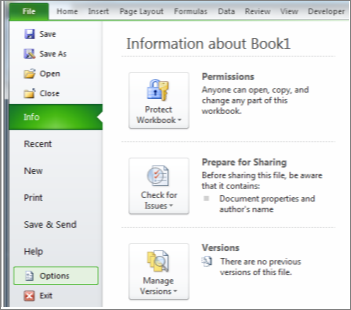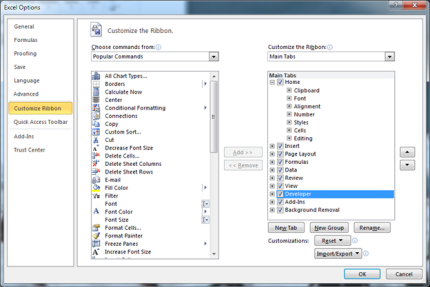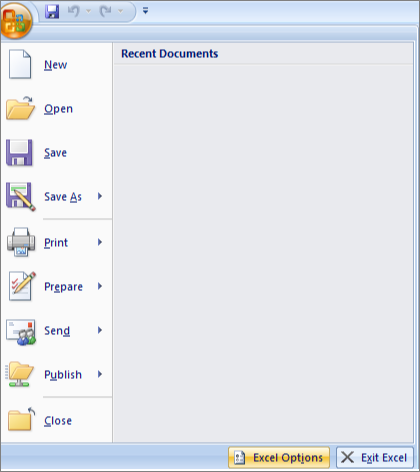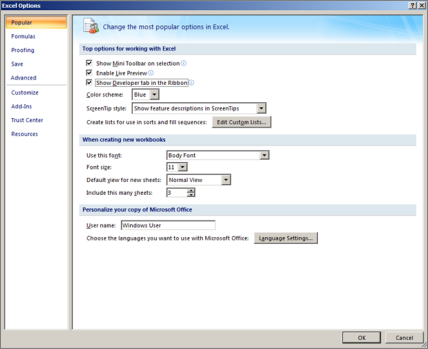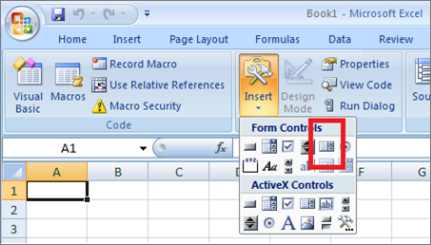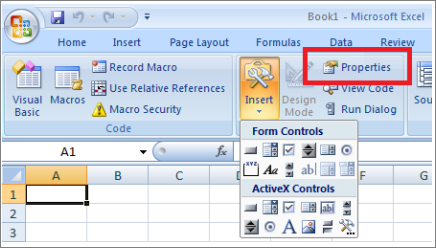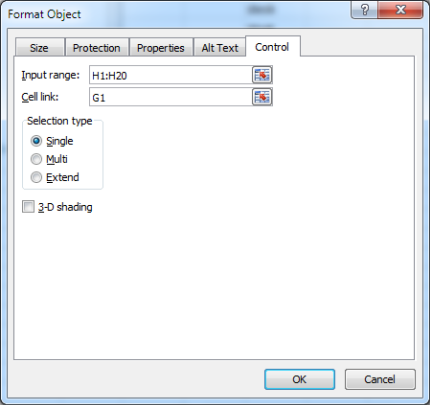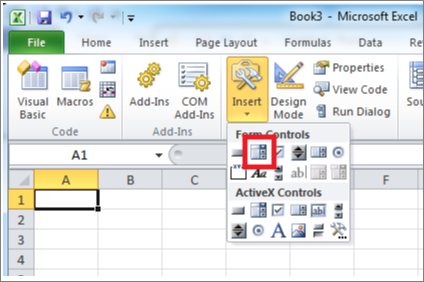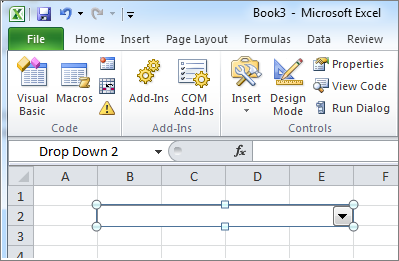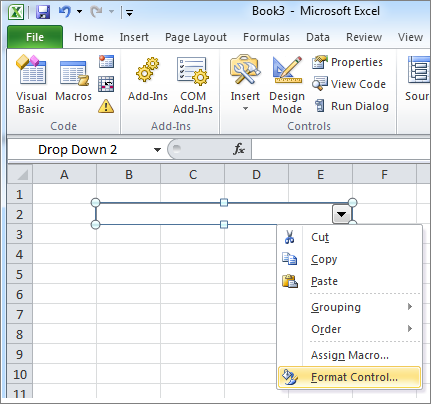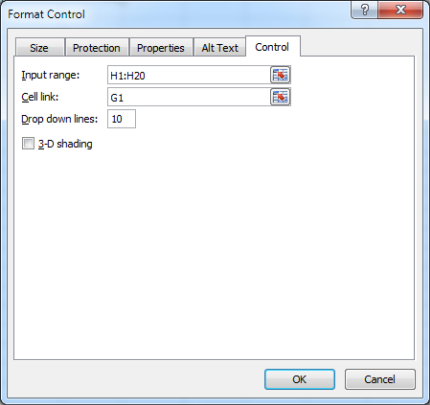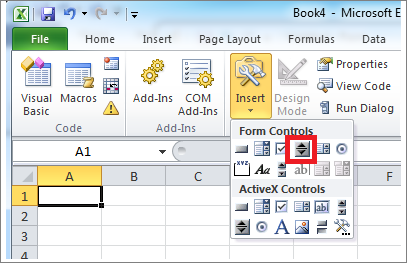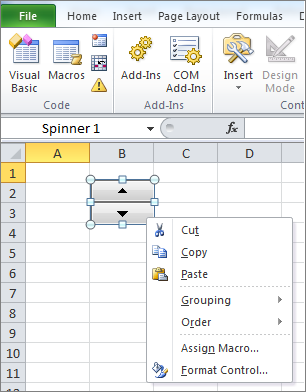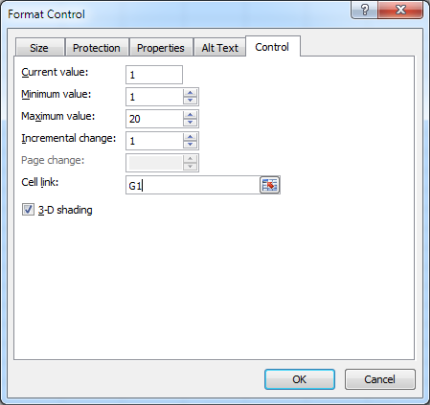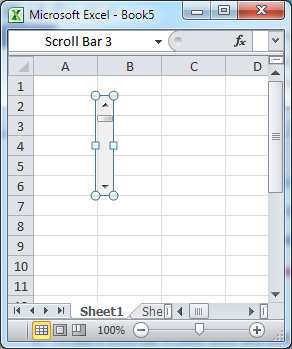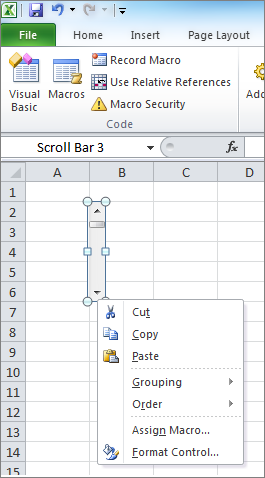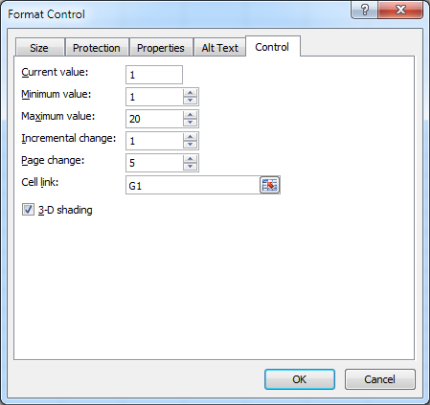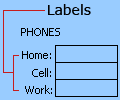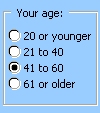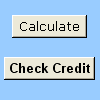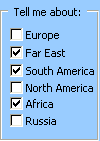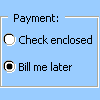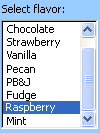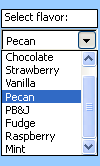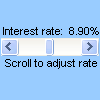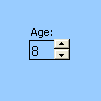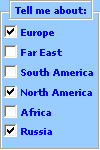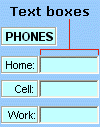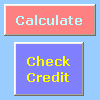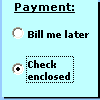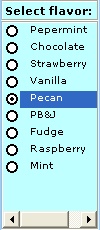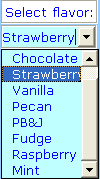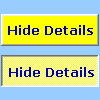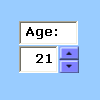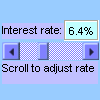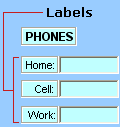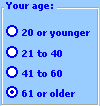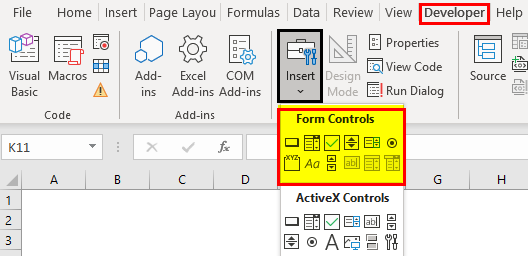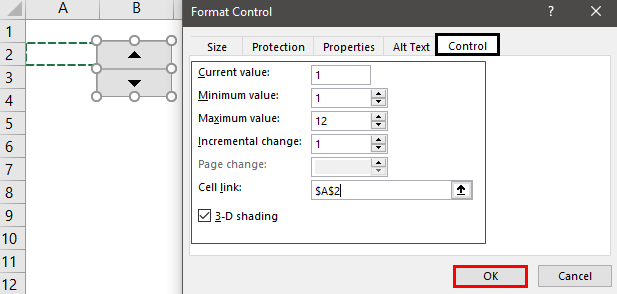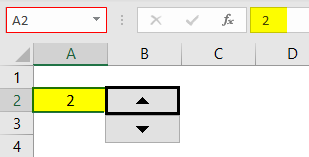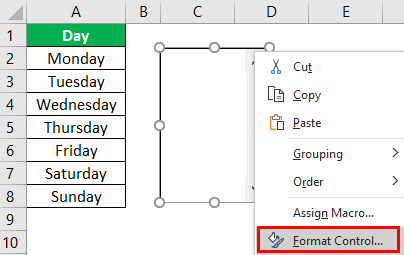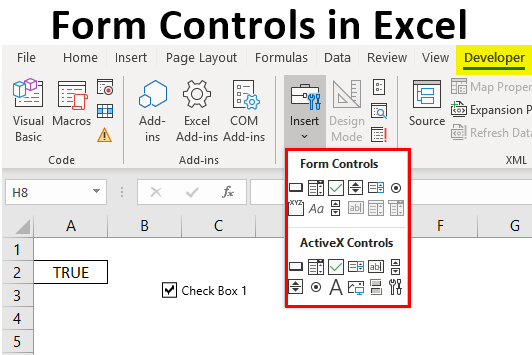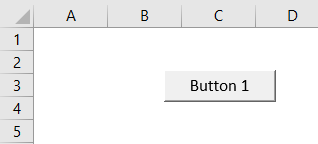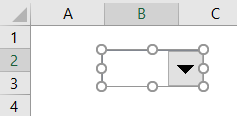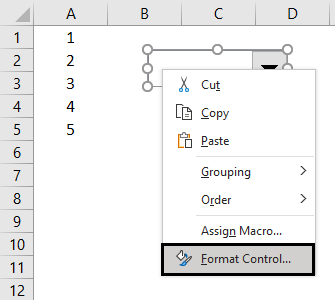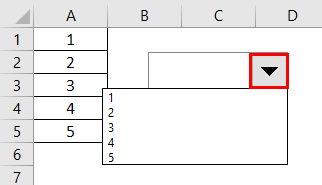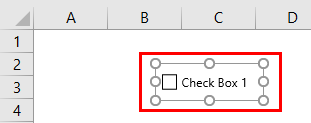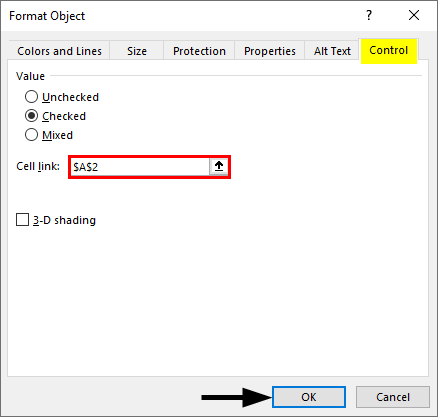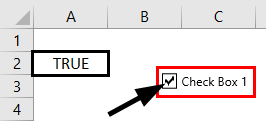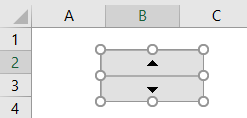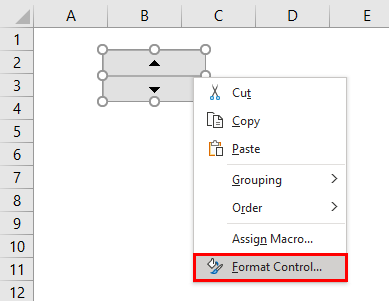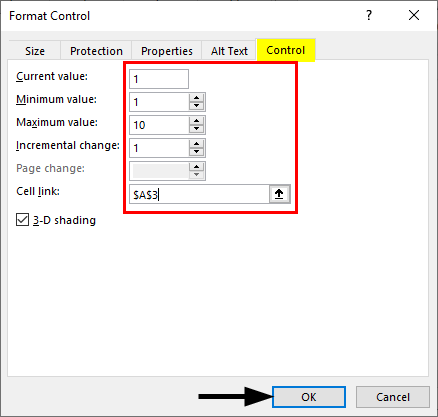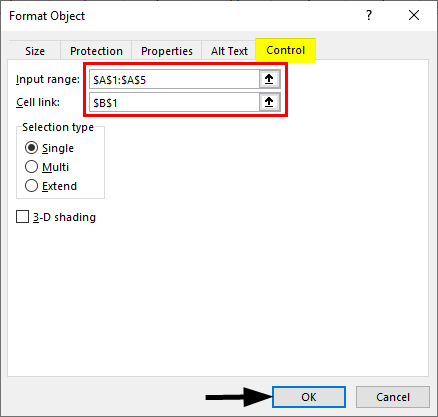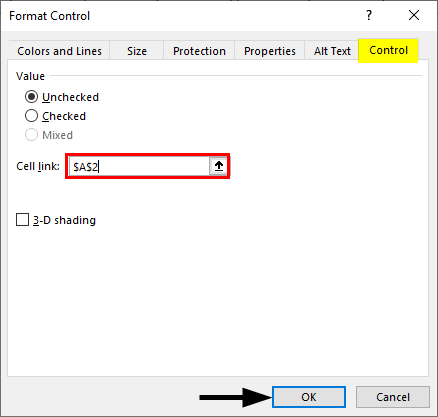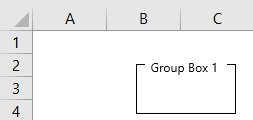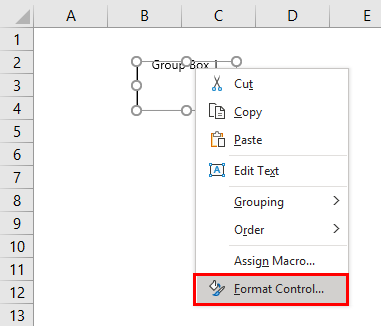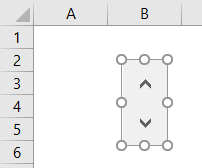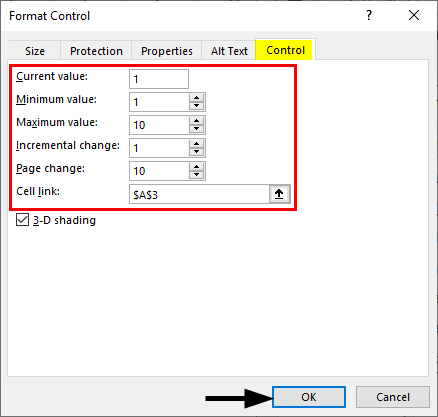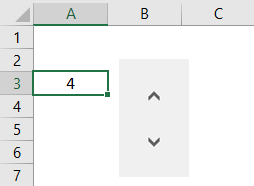Summary
More Information
The following methods show how to use list boxes, combo boxes, spin buttons, and scroll bars. The examples use the same list, cell link, and Index function.
Enable the Developer tab
To use the form controls in Excel 2010 and later versions, you have to enable the Developer tab. To do this, follow these steps:
-
Click File, and then click Options.
-
Click Customize Ribbon in the left pane.
-
Select the Developer check box under Main Tabs on the right, and then click OK.
To use the forms controls in Excel 2007, you must enable the Developer tab. To do this, follow these steps:
-
Click the Microsoft Office Button, and then click Excel Options.
-
Click Popular, select the Show Developertab in the Ribbon check box, and then click OK.
Set up the list, the cell link, and the index
-
In a new worksheet, type the following items in the range H1:H20:
H1 : Roller Skates
H2 : VCR
H3 : Desk
H4 : Mug
H5 : Car
H6 : Washing Machine
H7 : Rocket Launcher
H8 : Bike
H9 : Phone
H10: Candle
H11: Candy
H12: Speakers
H13: Dress
H14: Blanket
H15: Dryer
H16: Guitar
H17: Dryer
H18: Tool Set
H19: VCR
H20: Hard Disk
-
In cell A1, type the following formula:
=INDEX(H1:H20,G1,0)
List box example
-
To add a list box in Excel 2007 and later versions, click the Developer tab, click Insert in the Controls group, and then click List Box Form (Control) under Form Controls.
To add a list box in Excel 2003 and in earlier versions of Excel, click the List Box button on the Forms toolbar. If the Forms toolbar is not visible, point to Toolbars on the View menu, and then click Forms.
-
Click the worksheet location where you want the upper-left corner of the list box to appear, and then drag the list box to where you want the lower-right corner of the list box to be. In this example, create a list box that covers cells B2:E10.
-
In the Controls group, click Properties.
-
In the Format Object window, type the following information, and then click OK.
-
To specify the range for the list, type H1:H20 in the Input range box.
-
To put a number value in cell G1 (depending on which item is selected in the list), type G1 in the Cell link box.
Note: The INDEX() formula uses the value in G1 to return the correct list item.
-
Under Selection type, make sure that the Single option is selected.
Note: The Multi and Extend options are only useful when you are using a Microsoft Visual Basic for Applications procedure to return the values of the list. Note also that the 3-D shading check box adds a three-dimensional look to the list box.
-
-
The list box should display the list of items. To use the list box, click any cell so that the list box is not selected. If you click an item in the list, cell G1 is updated to a number that indicates the position of the item that is selected in the list. The INDEX formula in cell A1 uses this number to display the item’s name.
Combo box example
-
To add a combo box in Excel 2007 and later versions, click the Developer tab, click Insert, and then click Combo Box under Form Controls.
To add a combo box in Excel 2003 and in earlier versions of Excel, click the Combo Box button on the Forms toolbar.
-
Click the worksheet location where you want the upper-left corner of the combo box to appear, and then drag the combo box to where you want the lower-right corner of the list box to be. In this example, create a combo box that covers cells B2:E2.
-
Right-click the combo box, and then click Format Control.
-
Type the following information, and then click OK:
-
To specify the range for the list, type H1:H20 in the Input range box.
-
To put a number value in cell G1 (depending on which item is selected in the list), type G1 in the Cell link box.
Note: The INDEX formula uses the value in G1 to return the correct list item.
-
In the Drop down lines box, type 10. This entry determines how many items will be displayed before you have to use a scroll bar to view the other items.
Note: The 3-D shading check box is optional. It adds a three-dimensional look to the drop-down or combo box.
-
-
The drop-down box or combo box should display the list of items. To use the drop-down box or combo box, click any cell so that the object is not selected. When you click an item in the drop-down box or combo box, cell G1 is updated to a number that indicates the position in the list of the item selected. The INDEX formula in cell A1 uses this number to display the item’s name.
Spin button example
-
To add a spin button in Excel 2007 and later versions, click the Developer tab, click Insert, and then click Spin Button under Form Controls.
To add a spinner in Excel 2003 and in earlier versions of Excel, click the Spinner button on the Forms toolbar.
-
Click the worksheet location where you want the upper-left corner of the spin button to appear, and then drag the spin button to where you want the lower-right corner of the spin button to be. In this example, create a spin button that covers cells B2: B3.
-
Right-click the spin button, and then click Format Control.
-
Type the following information, and then click OK:
-
In the Current value box, type 1.
This value initializes the spin button so that the INDEX formula will point to the first item in the list.
-
In the Minimum value box, type 1.
This value restricts the top of the spin button to the first item in the list.
-
In the Maximum value box, type 20.
This number specifies the maximum number of entries in the list.
-
In the Incremental change box, type 1.
This value controls how much the spin button control increments the current value.
-
To put a number value in cell G1 (depending on which item is selected in the list), type G1 in the Cell link box.
-
-
Click any cell so that the spin button is not selected. When you click the up control or down control on the spin button, cell G1 is updated to a number that indicates the current value of the spin button plus or minus the incremental change of the spin button. This number then updates the INDEX formula in cell A1 to show the next or previous item.
The spin button value will not change if the current value is 1 and you click the down control, or if the current value is 20 and you click the up control.
Scroll bar example
-
To add a scroll bar in Excel 2007 and later versions, click the Developer tab, click Insert, and then click Scroll Bar under Form Controls.
To add a scroll bar in Excel 2003 and in earlier versions of Excel, click the Scroll Bar button on the Forms toolbar.
-
Click the worksheet location where you want the upper-left corner of the scroll bar to appear, and then drag the scroll bar to where you want the lower-right corner of the scroll bar to be. In this example, create a scroll bar that covers cells B2:B6 in height and is about one-fourth of the width of the column.
-
Right-click the scroll bar, and then click Format Control.
-
Type the following information, and then click OK:
-
In the Current value box, type 1.
This value initializes the scroll bar so that the INDEX formula will point to the first item in the list.
-
In the Minimum value box, type 1.
This value restricts the top of the scroll bar to the first item in the list.
-
In the Maximum value box, type 20. This number specifies the maximum number of entries in the list.
-
In the Incremental change box, type 1.
This value controls how many numbers the scroll bar control increments the current value.
-
In the Page change box, type 5. This value controls how much the current value will be incremented if you click inside the scroll bar on either side of the scroll box).
-
To put a number value in cell G1 (depending on which item is selected in the list), type G1 in the Cell link box.
Note: The 3-D shading check box is optional. It adds a three-dimensional look to the scroll bar.
-
-
Click any cell so that the scroll bar is not selected. When you click the up or down control on the scroll bar, cell G1 is updated to a number that indicates the current value of the scroll bar plus or minus the incremental change of the scroll bar. This number is used in the INDEX formula in cell A1 to show the item next to or before the current item. You can also drag the scroll box to change the value or click in the scroll bar on either side of the scroll box to increment it by 5 (the Page change value). The scroll bar will not change if the current value is 1 and you click the down control, or if the current value is 20 and you click the up control.

A worksheet form is not the same thing as an Excel template. A template is a pre-formatted file that can get you started creating a workbook that looks the way you want. A form contains controls, such as boxes or dropdown lists, that can make it easier for people who use your worksheet to enter or edit data. To find out more about templates you can download, see Excel templates.
What is a form?
A form, whether printed or online, is a document designed with a standard structure and format that makes it easier to capture, organize, and edit information.
-
Printed forms contain instructions, formatting, labels, and blank spaces for writing or typing data. You can use Excel and Excel templates to create printed forms.
-
Online forms contain the same features as printed forms. In addition, online forms contain controls. Controls are objects that display data or make it easier for users to enter or edit data, perform an action, or make a selection. In general, controls make the form easier to use. Examples of common controls include list boxes, option buttons, and command buttons. Controls can also run assigned macros and respond to events, such as mouse clicks, by running Visual Basic for Applications (VBA) code.
You can use Excel in several ways to create printed and online forms.
Types of Excel forms
There are several types of forms that you can create in Excel: data forms, worksheets that contain Form and ActiveX controls, and VBA UserForms. You can use each type of form by itself, or you can combine them in different ways to create a solution that’s right for you.
Data form
A data form provides a convenient way to enter or display one complete row of information in a range or table without scrolling horizontally. You may find that using a data form can make data entry easier than moving from column to column when you have more columns of data than can be viewed on the screen. Use a data form when a simple form of text boxes that list the column headings as labels is sufficient and you don’t need sophisticated or custom form features, such as a list box or spin button.
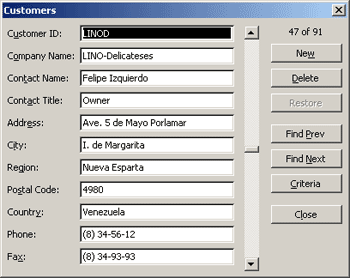
Worksheet with Form and ActiveX controls
A worksheet is a type of form that enables you to enter and view data on the grid, and there are several control-like features already built-in to Excel worksheets, such as comments and data validation. Cells resemble text boxes in that you can enter and format them in a variety of ways. Cells are often used as labels, and by adjusting cell height and width and merging cells, you can make a worksheet behave like a simple data entry form. Other control-like features, such as cell comments, hyperlinks, background images, data validation, conditional formatting, embedded charts, and AutoFilter can make a worksheet behave like an advanced form.
For added flexibility, you can add controls and other drawing objects to the drawing canvas of a worksheet, and combine and coordinate them with worksheet cells. For example, you can use a list box control to make it easier for a user to select from a list of items. Or, you can use a spin button control to make it easier for a user to enter a number.
Because controls and objects are stored on the drawing canvas, you can display or view controls and objects alongside associated text that is independent of row and column boundaries without changing the layout of a grid or table of data on your worksheet. Most of the time, many of these controls can also be linked to cells on the worksheet and do not require VBA code to make them work. You can set properties that determine whether a control floats freely or moves and resizes together with a cell. For example, you might have a check box that you want to move together with its underlying cell when the range is sorted. However, if you have a list box that you want to keep in a specific location at all times, you probably do not want it to move together with its underlying cell.
Excel has two types of controls: Form controls and ActiveX Controls. In addition to these sets of controls, you can also add objects from the Drawing tools, such as a AutoShapes, WordArt, SmartArt graphic, or text boxes.
The following sections describe these controls and drawing objects, and also explain how to work with these controls and objects in more detail.
Form controls
Form controls are the original controls that are compatible with earlier versions of Excel, starting with Excel version 5.0. Form controls are also designed for use on XLM macro sheets.
You use Form controls when you want to easily reference and interact with cell data without using VBA code, and when you want to add controls to chart sheets. For example, after you add a list box control to a worksheet and linking it to a cell, you can return a numeric value for the current position of the selected item in the control. You can then use that numeric value in conjunction with the INDEX function to select different items from the list.
You can also run macros by using Form controls. You can attach an existing macro to a control, or write or record a new macro. When a user of the form clicks the control, the control runs the macro.
However, these controls cannot be added to UserForms, used to control events, or modified to run Web scripts on Web pages.
Summary of form controls
|
Button Name |
Example |
Description |
|
|---|---|---|---|
|
|
Label |
|
Identifies the purpose of a cell or text box, or displays descriptive text (such as titles, captions, pictures) or brief instructions. |
|
|
Group box |
|
Groups related controls into one visual unit in a rectangle with an optional label. Typically, option buttons, check boxes, or closely related contents are grouped. |
|
|
Button |
|
Runs a macro that performs an action when a user clicks it. A button is also referred to as a push button. |
|
|
Check box |
|
Turns on or off a value that indicates an opposite and unambiguous choice. You can select more than one check box on a worksheet or in a group box. A check box can have one of three states: selected (turned on), cleared (turned off), and mixed, meaning a combination of on and off states (as in a multiple selection). |
|
|
Option button |
|
Allows a single choice within a limited set of mutually exclusive choices; an option button is usually contained in a group box or a frame. An option button can have one of three states: selected (turned on), cleared (turned off), and mixed, meaning a combination of on and off states (as in a multiple selection). An option button is also referred to as a radio button. |
|
|
List box |
|
Displays a list of one or more items of text from which a user can choose. Use a list box for displaying large numbers of choices that vary in number or content. There are three types of list boxes:
|
|
|
Combo box |
|
Combines a text box with a list box to create a drop-down list box. A combo box is more compact than a list box but requires the user to click the down arrow to display the list of items. Use a combo box to enable a user to either type an entry or choose only one item from the list. The control displays the current value in the text box, regardless of how that value is entered. |
|
|
Scroll bar |
|
Scrolls through a range of values when you click the scroll arrows or drag the scroll box. In addition, you can move through a page (a preset interval) of values by clicking the area between the scroll box and either of the scroll arrows. Typically, a user can also type a text value directly into an associated cell or text box. |
|
|
Spin button |
|
Increases or decreases a value, such as a number increment, time, or date. To increase the value, click the up arrow; to decrease the value, click the down arrow. Typically, a user can also type a text value directly into an associated cell or text box. |
Note: The following controls are unavailable in Office Excel 2007 workbooks. These controls can be used in Excel version 5.0 dialog sheets only.
|
Button Name |
|---|
|
|
|
|
|
|
|
|
ActiveX controls
ActiveX controls can be used on worksheet forms, with or without the use of VBA code, and on VBA UserForms. In general, use ActiveX controls when you need more flexible design requirements than those provided by Form controls. ActiveX controls have extensive properties that you can use to customize their appearance, behavior, fonts, and other characteristics.
You can also control different events that occur when an ActiveX control is interacted with. For example, you can perform different actions, depending on which choice a user selects from a list box control, or you can query a database to refill a combo box with items when a user clicks a button. You can also write macros that respond to events associated with ActiveX controls. When a user of the form interacts with the control, your VBA code then runs to process any events that occur for that control.
Your computer also contains many ActiveX controls that were installed by Excel and other programs, such as Calendar Control 12.0 and Windows Media Player.
Important: Not all ActiveX controls can be used directly on worksheets; some can be used only on Visual Basic for Applications (VBA) UserForms. If you try to add any one of these particular ActiveX controls to a worksheet, Excel displays the message «Cannot insert object.»
However, ActiveX controls cannot be added to chart sheets from the user interface or to XLM macro sheets. You also cannot assign a macro to run directly from an ActiveX control the same way you can from a Form control.
Summary of ActiveX controls
|
Button Name |
Example |
Description |
|
|---|---|---|---|
|
|
Check box |
|
Turns on or off a value that indicates an opposite and unambiguous choice. You can select more than one check box at a time on a worksheet or in a group box. A check box can have one of three states: selected (turned on), cleared (turned off), and mixed, meaning a combination of on and off states (as in a multiple selection). |
|
|
Text box |
|
Enables you to, in a rectangular box, view, type, or edit text or data that is bound to a cell. A text box can also be a static text field that presents read-only information. |
|
|
Command button |
|
Runs a macro that performs an action when a user clicks it. A command button is also referred to as a push button. |
|
|
Option button |
|
Allows a single choice within a limited set of mutually exclusive choices usually contained in a group box or frame. An option button can have one of three states: selected (turned on), cleared (turned off), and mixed, meaning a combination of on and off states (as in a multiple selection). An option button is also referred to as a radio button. |
|
|
List box |
|
Displays a list of one or more items of text from which a user can choose. Use a list box for displaying large numbers of choices that vary in number or content. There are three types of list boxes:
|
|
|
Combo box |
|
Combines a text box with a list box to create a drop-down list box. A combo box is more compact than a list box, but requires the user to click the down arrow to display the list of items. Use to allow a user to either type an entry or choose only one item from the list. The control displays the current value in the text box, regardless of how that value is entered. |
|
|
Toggle button |
|
Indicates a state, such as Yes/No, or a mode, such as On/Off. The button alternates between an enabled and disabled state when it is clicked. |
|
|
Spin button |
|
Increases or decreases a value, such as a number increment, time, or date. To increase the value, click the up arrow; to decrease the value, click the down arrow. Typically, a user can also type a text value into an associated cell or text box. |
|
|
Scroll bar |
|
Scrolls through a range of values when you click the scroll arrows or drag the scroll box. In addition, you can move through a page (a preset interval) of values by clicking the area between the scroll box and either of the scroll arrows. Typically, a user can also type a text value directly into an associated cell or text box. |
|
|
Label |
|
Identifies the purpose of a cell or text box, displays descriptive text (such as titles, captions, pictures), or provides brief instructions. |
|
|
Image |
|
Embeds a picture, such as a bitmap, JPEG, or GIF. |
|
Frame control |
|
A rectangular object with an optional label that groups related controls into one visual unit. Typically, option buttons, check boxes, or closely related contents are grouped in a frame control. Note: The ActiveX frame control is not available in the ActiveX Controls section of the Insert command. However, you can add the control from the More Controls dialog box by selecting Microsoft Forms 2.0 Frame. |
|
|
|
More Controls |
Displays a list of additional ActiveX controls available on your computer that you can add to a custom form, such as Calendar Control 12.0 and Windows Media Player. You can also register a custom control in this dialog box. |
Drawing Tool objects
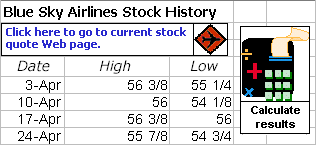
Working with controls and objects on the worksheet form
After adding forms and ActiveX to a worksheet form, you usually want to fine-tune and rearrange the controls in a variety of ways to create a well-designed, user friendly form. Common tasks include the following:
-
Controlling the display of gridlines while you work with the controls, and deciding whether to display the gridlines to the user on the final worksheet form.
-
Selecting and deselecting controls so that you can specify properties or make additional adjustments.
-
Editing text in a control, such as the caption or label.
-
Grouping, copying, moving, and aligning controls to organize the layout of the worksheet form.
-
Resizing and formatting controls to obtain the appearance that you want.
-
Positioning or sizing a control with a cell.
-
Protecting controls and linked cells according to your specific data protection needs.
-
Enabling or disabling the printing of controls when the worksheet form is printed.
-
Deleting unused controls.
You can design a worksheet form with or without cell gridlines in the background. For example, you might want to turn off cell gridlines and then format all the cells with the same color or pattern, or even use a picture as a sheet background. To hide or show the gridlines, on the View tab, in the Show/Hide group, clear or select the Gridlines check box.
Determining the type of control that is on your worksheet
Because there are three different types of controls and objects that you can modify uniquely, you might not know for sure which type of control it is just by looking at it. To determine the type of control (Form or ActiveX), select and right-click the control, and then display the shortcut menu:
-
If the shortcut menu contains the command Properties, the control is an ActiveX control, and you are in design mode.
-
If the shortcut menu contains the command Assign Macro, the control is a Form control.
Tip: To display the correct shortcut menu for the group box Form control, make sure that you select the perimeter instead of the interior of the group box.
-
If the shortcut menu contains the command Edit Text, the object is a Drawing object.
VBA UserForms
For maximum flexibility, you can create UserForms, which are custom dialog boxes, that usually include one or more ActiveX controls. You make UserForms available from VBA code that you create in the Visual Basic Editor. The high-level steps for creating a UserForm are as follows:
-
Insert a UserForm into your workbook’s VBAProject. You access a workbook’s VBAProject by first displaying the Visual Basic Editor (press ALT+F11) and then, on the Insert menu, clicking UserForm.
-
Write a procedure to display the UserForm.
-
Add ActiveX controls.
-
Modify properties for the ActiveX controls.
-
Write event-handler procedures for the ActiveX controls.
By using UserForms, you can also utilize advanced form functionality,. For example, you can programmatically add a separate option button for each letter of the alphabet or you can add a check box for each item in a large list of dates and numbers.
Before creating a UserForm, consider using built-in dialog boxes available from Excel that might fit your needs. These built-in dialog boxes include the VBA InputBox and MsgBox functions, the Excel InputBox method, GetOpenFilename method, GetSaveAsFilename method, and the Dialogs object of the Application object, which contains all the built-in Excel dialog boxes.
For more information, explore the Microsoft Office Excel Developer Center.
Top of Page
To use the form controls in Excel 2010 and later versions, you have to enable the Developer tab.
Enable the Developer tab
- Click File, and then click Options.
- Click Customize Ribbon in the left pane.
- Select the Developer check box under Main Tabs on the right, and then click OK.
Contents
- 1 How do I access form control in Excel?
- 2 What’s the difference between form controls and ActiveX controls in Excel?
- 3 How do I use form control in Excel VBA?
- 4 How do I use ActiveX?
- 5 Which is an example of a form control?
- 6 How do I use form controls in Excel 2016?
- 7 How do I add interactive buttons in Excel?
- 8 What is VBA in Excel?
- 9 What are form controls in Excel?
- 10 What is the use of form control in angular?
- 11 How do I enable ActiveX controls in Excel?
- 12 What is a form control?
- 13 How do I use ActiveX text box in Excel?
- 14 How do I enable developer tools in Excel?
- 15 How do I enable ActiveX controls?
- 16 How do I change the ActiveX controls in Excel?
- 17 Why form control is used?
- 18 Where is the form tool in Excel?
- 19 How do you create a selection button in Excel?
- 20 How do you group buttons in Excel?
How do I access form control in Excel?
- On the Developer tab, click Insert in the Controls group.
- In the Form Controls group, click the check box or option button icon, and then click on the worksheet where you want to place the control.
- Right-click the control and choose Format Control.
What’s the difference between form controls and ActiveX controls in Excel?
As Hans Passant said, Form controls are built in to Excel whereas ActiveX controls are loaded separately. Generally you’ll use Forms controls, they’re simpler. ActiveX controls allow for more flexible design and should be used when the job just can’t be done with a basic Forms control.
How do I use form control in Excel VBA?
Using Excel Form Controls
- Go to Visual Basic Editor (ALT+F11)
- Insert UserForm.
- Select the UserForm, you should see Toolbox with all userform controls.
- If the Toolbox is not displayed, you can enable if from View menu.
- Select any userform control and draw it on the userform.
- Design the form as per your desire.
How do I use ActiveX?
On the Developer tab, in the Controls group, click Insert, and then under ActiveX Controls, select a control, or click More Controls to view all the available ActiveX controls, and then select a control. Click the worksheet location where you want the ActiveX control to appear.
Which is an example of a form control?
In general, controls make the form easier to use. Examples of common controls include list boxes, option buttons, and command buttons.
Right-click the combo box, and then click Format Control. Type the following information, and then click OK: To specify the range for the list, type H1:H20 in the Input range box. To put a number value in cell G1 (depending on which item is selected in the list), type G1 in the Cell link box.
How do I add interactive buttons in Excel?
Insert the Option Buttons
- Click the Developer tab on the Ribbon.
- Click the Insert button in the Controls group.
- Click on the Option Button under the Form Controls header.
- Click on the spreadsheet where you want to position the control and repeat this step for the number of option buttons that you need.
What is VBA in Excel?
VBA stands for Visual Basic for Applications. Excel VBA is Microsoft’s programming language for Excel.and all the other Microsoft Office programs, like Word and PowerPoint. The Office suite programs all share a common programming language.
What are form controls in Excel?
Excel Form Controls are objects which can be inserted at any place in the worksheet to work with data and handle the data as specified. Using these form controls in excel we can create a drop-down list in excel. read more, list boxes, spinners, checkboxes, scroll bars.
What is the use of form control in angular?
What are form controls in Angular? In Angular, form controls are classes that can hold both the data values and the validation information of any form element. Every form input you have in a reactive form should be bound by a form control. These are the basic units that make up reactive forms.
How do I enable ActiveX controls in Excel?
Use the following instructions to enable or disable ActiveX controls in the Trust Center.
- Click File > Options.
- Click Trust Center > Trust Center Settings > ActiveX Settings.
- Click the options you want, and then click OK.
What is a form control?
A form control is a user interface control that serves as the point of connection between the user and the server. Interactions vary by control type: buttons: button file handling: input type=”file” menus: select , etc. And are also grouped into categories.
How do I use ActiveX text box in Excel?
Add a text box (ActiveX control)
- Click Developer and then click Insert, and under ActiveX Controls, click Text Box .
- Click the worksheet location where you want the upper-left corner of the text box to appear.
- To edit the ActiveX control, click Design Mode .
- To specify the control properties, click Properties .
How do I enable developer tools in Excel?
The Developer tab isn’t displayed by default, but you can add it to the ribbon.
- On the File tab, go to Options > Customize Ribbon.
- Under Customize the Ribbon and under Main Tabs, select the Developer check box.
How do I enable ActiveX controls?
Enable ActiveX controls in Internet Explorer
- Click Tools > Internet Options.
- Click the Security tab > Custom Level.
- Scroll down to ActiveX controls and plugins and click Enable for:
- Click OK to close the dialog boxes, and then restart Internet Explorer.
How do I change the ActiveX controls in Excel?
Edit the text in an ActiveX control
- If the Developer tab is not available, display it.
- Make sure that you are in design mode.
- Select the ActiveX control.
- Right-click the selection.
- Point to the name of the object (for example, CheckBox Object), and then click Edit.
- Edit the text for the control.
Why form control is used?
Form controls enable accessibility by taking a uniform approach to such features as captions, help text, tabbing and keyboard shortcuts. Internationalization issues are addressed by following the same design principles as in XHTML. All form controls are suitable for styling using Aural CSS (ACSS) style properties.
Where is the form tool in Excel?
Click the Tools drop down menu under Menus tab; Click the Controls item; Click the Insert item; Then you will view the Form Controls buttons, that’s original Forms Toolbar.
How do you create a selection button in Excel?
In Excel 2007, click the Microsoft Office button > Excel Options > Popular > Show Developer tab in the Ribbon.
- To add a check box, click the Developer tab, click Insert, and under Form Controls, click .
- Click in the cell where you want to add the check box or option button control.
How do you group buttons in Excel?
Here are the steps to group radio buttons in Excel:
- Insert all the radio buttons that you want to group.
- Go to Developer –> Controls –> Insert –> Group Box (Form Control).
- Hover the mouse anywhere in the worksheet.
- Place the group box in such a way that all the radio buttons (that you want to group) are inside it.
Excel Form Controls are objects that we can insert into the worksheet to work with data and handle the data as specified. For example, using these form controls in Excel, we can create a drop-down list in excelA drop-down list in excel is a pre-defined list of inputs that allows users to select an option.read more, list boxes, spinners, checkboxes, and scroll bars.
Table of contents
- Excel Form Controls
- How to use Form Controls in Excel?
- Form Control 1: Button
- Form Control 2: Combo Box
- Form Control 3: CheckBox
- Form Control 4: Spin Button
- Form Control 5: List Box
- Form Control 6: Group Box
- Form Control 7: Label
- Form Control 8: Scroll Bar
- Things to Remember
- Recommended Articles
- How to use Form Controls in Excel?
“Form Controls” is available in Excel under the “Developer” tab excel.
As we can see, we have two categories, “Form Controls” and “Active X Controls.” In this article, we are concentrating only on “Form Controls.” The below image describes all the “Form Controls” in Excel.
You are free to use this image on your website, templates, etc, Please provide us with an attribution linkArticle Link to be Hyperlinked
For eg:
Source: Form Controls in Excel (wallstreetmojo.com)
How to use Form Controls in Excel?
Now, we will see how to work with each in detail.
You can download this Form Controls Excel Template here – Form Controls Excel Template
Form Control 1: Button
This option is to draw a button and assign any macro name to it so that the assigned macro can run when we click this button.
Form Control 2: Combo Box
The combo box is our drop-down list. It works the same as the drop-down list, but combo box excelCombo Box in Excel is a type of data validation tool that can create a dropdown list for the user to select from the pre-determined list. It is a form control which is available in the insert tab of the developer’s tab.read more is considered an object.
We must select the “ComboBox” and draw anywhere on the worksheet area.
To insert values, we must create a day list in column A.
Now, select the “Combo Box,” right-click and choose “Format Control.”
Now in the “Format Control” window, choose “Control.” Then, in the “Input range,” choose the month names range of cells. Then, click on “OK.”
Now, we can see the selected day list in the combo box.
Form Control 3: CheckBox
The checkbox is used to display the item selection. If checked, we can link to a certain cell to show the selection as “TRUE” and “FALSE” if unchecked.
We must first draw the checkbox on the worksheet.
Then, right-click and choose the “Edit Text” option.
Change the default name from “Check Box1” to “Option.”
Again, right-click and choose “Format Control.”
Under the “Control” tab, we must choose “Unchecked” and give the “Cell link” to the D3 cell. Click “OK.”
Now, check the box to see the “TRUE” value in cell D3.
And uncheck the box to see the “FALSE” value.
Form Control 4: Spin Button
Using the “Spin Button,” we can increment and decrement the value in the linked cell. We need to draw the spin button to see options.
Then, right-click on the button and choose “Format Control.”
Under the “Control” tab, we can make all the settings. We can set a minimum value, maximum value, and current value. Also, we can configure what should be the incremental and decremented value when the spin button is clicked. Click “OK.”
Now, if we click up the arrow of the spin button in cell A2 one, we can see the incremental value.
And if we click on the down arrow of a spin button in cell A2, we can see every time it will be decreased by one.
Another thing is in the “Format Control” window, we have set 1 as the “Minimum value” and 12 as the “Maximum value.”
So, when we press the up arrow, it will increment by 1 until it reaches 12. After that, it will not increase.
Form Control 5: List Box
Using the list box in excelThe list box in Excel VBA is a list assigned to a variable with a variety of inputs to select from. It allows multiple options to be selected at the same time and can be added on a UserForm using the list box option.read more, we can create a list of items. Let’s first draw the box and then configure it.
For this list box, we will create a list of days.
Then, right-click on the “List Box” and choose “Format Control.”
Now, under the “Control” tab for “Input range,” choose the day list, and for “Cell link,” choose C10 cell. Since we have selected “Single” under the “Selection type,” we can select only one item at a time. Then, click “OK.”
Now, see the list of days in the list box.
Now select any item from the list to see what we get in linked cell C10.
As we can see above, we have 6 as the value in cell C10. From the list box, we have selected “Saturday,” which is the 6th item, so the result in cell C10 is 6.
Form Control 6: Group Box
Using the group box, we can create multiple controls. We cannot interact with this; rather, it allows us to group other controls under one roof.
We must first draw the group box on the sheet.
Then, right-click on the “Group Box” and choose “Format Control.”
Insert the radio buttonsIn Excel, radio buttons or options buttons record a user’s input. They can be found in the developer’s tab’s insert section. read more that we want to group.
Form Control 7: Label
The label does not have any interactivity with users. It will only display the value entered or cell referencedCell reference in excel is referring the other cells to a cell to use its values or properties. For instance, if we have data in cell A2 and want to use that in cell A1, use =A2 in cell A1, and this will copy the A2 value in A1.read more value, i.e., Welcome.
Form Control 8: Scroll Bar
Using the Scroll Bar in ExcelIn Excel, there are two scroll bars: one is a vertical scroll bar that is used to view data from up and down, and the other is a horizontal scroll bar that is used to view data from left to right.read more, can increment and decrement the linked cell value. It is similar to “Spin Button.” But in a scroll bar, we can see the scroll moving upon increasing and decreasing.
We need to draw the scroll bar first on the sheet.
Then, right-click on the button and choose “Format Control.”
Under the “Control” tab, we can make all the settings.
So, when we press the up arrow, it will increment by 1 until it reaches 12; then, it will not increase.
Things to Remember
- This article is just an introduction to how form controls work in Excel.
- Using these form controls in Excel, we can create interactive charts and dashboards.
- Active X Controls are used primarily with VBA codingVBA code refers to a set of instructions written by the user in the Visual Basic Applications programming language on a Visual Basic Editor (VBE) to perform a specific task.read more.
Recommended Articles
This article is a guide to Form Controls in Excel. Here, we discuss how to use form controls in Excel using the button, combo box, spin button, list box, etc., along with examples and a downloadable Excel template. You may also look at these useful functions in Excel: –
- VBA Combo Box
- Excel Interactive Chart
- Insert Button in Excel
- Control Excel Charts
Excel Form Controls (Table of Contents)
- Introduction to Form Controls in Excel
- How to Use Form Control in Excel?
Introduction to Form Controls in Excel
Form Controls objects are used for creating buttons, boxes, list bar, and scrolls. Form controls can be accessed from the Developer menu tab with two types of sections in it. The first is Form Controls, and the other is ActiveX Controls. Here we will only be seeing Form Controls in detail. In Form Controls, we have Buttons, Combo box, CheckBox, Spin Button, List Box, Option Box, Group Box, Scroll Bar, Text Field, Combo List-Edit, Combo Drop Down-Edit, respectively. Below we have the screenshot.
How to Use Form Control in Excel?
Use Form Control and Go to the Developer menu tab (If activated from the File menu option). There we can find Form Control under the Control section, as shown in the below screenshot.
Form Controls in Excel allow us to create different types of controls by just selecting and dragging them anywhere in the worksheet. The work doesn’t end here; we will need to connect the inserted Form Controls with the data were; just by scrolling, checking the boxes, we would get some values output.
You can download this Form Controls Excel Template here – Form Controls Excel Template
Example #1
We will see all the objects in Form Control one by one in this example. For this, you just simply need to select the Form Control boxes from the menu option and drag and draw to get the button shape object.
1. Buttons – Once we select and draw this button, we will immediately get a dialog box of Assign Macro. Now there, edit and give a name to Macro Name. Here we have kept it as Button.
We will then get a button in the area where it is drawn.
We can edit the name of the button as well, just by putting the cursor on it.
To assign a macro to this button, right-click and select Assign Macro.
2. Combo box – To use Combo Box, select the option and draw anywhere in the sheet.
To assign value to the Combo Box drop-down, click right on it and select Format Control.
Select the range of input cells. Here it is from A1:A5 with drop down lines as 5.
Once done, click on the drop-down arrow, we will be able to see all the selected values. And we can select any value as well.
3. CheckBox – This is used when we just need to mark an option for status. Please select this option from Form Control and draw it.
Just by a single click on it, we will see a Tick inside the box.
Right-click on the box and select Format Controls. Select type and cell link as shown below.
When we check the CheckBox with a tick mark, we will get TRUE at the selected cell. And FALSE when uncheck.
4. Spin Button – As the name says, we can spinning around the selected values by this. Select and draw this on the worksheet.
Right-click and select Format Control.
Now under the Control tab, give the limit as per requirement and select cell link as well.
We can then click on the Up and Down arrow to navigate the from values from 1 to 12.
5. List Box – List Box can contain any range of list values. Select the option and draw anywhere in the sheet.
Right-click on any List menu and select Format Control. Then in the window of Format Control, select the Input range and Cell link. Here we have selected the range input range of numbers 1 to 5.
We will see, in the List box, all the numbers from the input range are seen. We can navigate to up and down and select and number. And the number will be seen in Cell Link B1.
6. Option Button – This is used when we need to select one option among others. Select and draw this anywhere in the worksheet.
Right-click on this and select Format Object. Now in the window below, select the Cell Link. We have select cell A2.
Now, if we select this option box, reference cell A2 will be seen with a value of 1. And unchecking it will show 0.
7. Group Box – This is used for multi controls. This only allows us to group other controls under it. Select and draw in a worksheet.
Right-click on it and select Format Control as shown below.
To group different controls here, we first need to have Radio control which is customized.
8. Label – Label works just as a simple sticker. Its main purpose is to show the value or text entered in it, as shown below.
9. Scroll Bar – With this, we can navigate the window up and down as we did in the List button. This is how it looks like below.
Right-click and select Format Object. From there, select the minimum and maximum value and cell link as well.
By clicking on the up and down arrow, we will see the change in cell A3, which is our cell link.
The rest of the Controls are not activated. All those left controls are customized.
Pros of Form Controls
- All the mentioned controls are easy to implement. And we all have seen some of them in any form of our work.
- The format Control option is the same for most of the control. So it becomes easy to select the range and cell link.
Things to Remember
- The second part of the Insert option, which is ActiveX, is only used for macros.
- Form Controls are used for both manual data and macros.
- Text Field, Combo List-Edit, and Combo Drop Down-Edit are customized form controls.
- Form Controls can also be used with charts.
Recommended Articles
This is a guide to Form Controls in Excel. Here we discuss how to use Form Controls in Excel and practical examples, and a downloadable excel template. You can also go through our other suggested articles –
- Sentence Case in Excel
- Excel Combo Box
- Examples of Excel Macros
- How to Edit Drop Down List in Excel?

